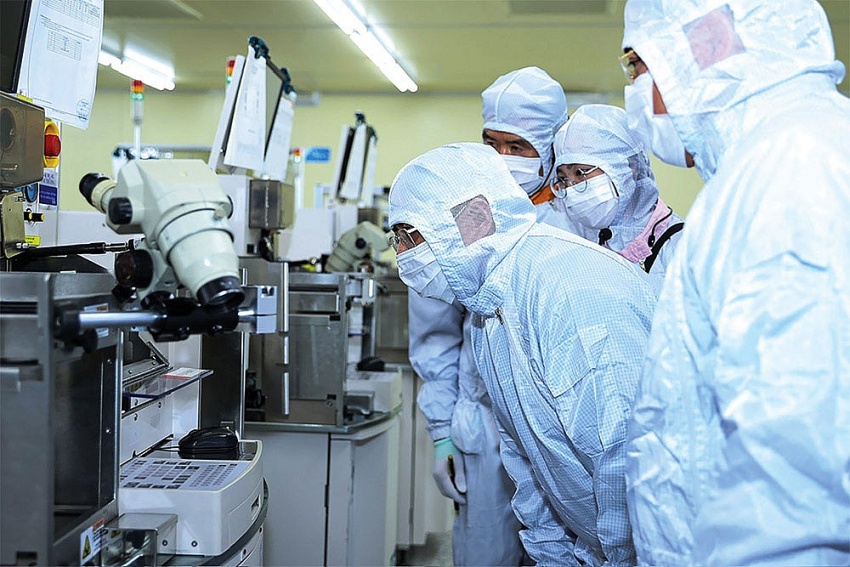Localities on first step towards training microchip labour force
April 25, 2024 | 13:00
Three manufacturers in the northern province of Bac Giang - Hana Micron Vina, Si Flex Vietnam, and Synergie Cad Vietnam - have plans to recruit thousands of workers from now until 2030.
 |
| Prime Minister Pham Minh Chinh visited Hana Micron Vina in Bac Giang province, Photo: Nhat Bac |
They are projected to recruit more than 1,800 additional workers this year and 6,300 in 2025–2030. They expect to recruit 1,200 of the 6,300 students who graduated from college onwards, and the remaining will be unskilled workers.
The total number of employees working for enterprises in semiconductors in the locality has now reached more than 8,000 people, only 20 per cent of whom are skilled labourers, experts, and engineers.
To meet these demands, they are collaborating with training facilities to raise the labour force. Within the framework of a conference organised by Bac Giang People’s Committee on April 16, South Korean semiconductor and memory chip manufacturer Hana Micron Vina signed agreements with the two colleges located in the province.
Hana Micron and Vietnam-Korea College of Technology (VKTech) signed a joint contract for the second time to train the labour force for outsourced semiconductor assembly and testing or back-end manufacturing. Besides this, the manufacturer and the Industrial Technical College, headquartered in Bac Giang city under the Ministry of Industry and Trade, also signed a cooperation agreement.
Despite the increasing demand, the training activity currently focuses on basic tasks like back-end manufacturing, assembly and testing, which accounts for low added value.
“The training contents are at a basic level. After this step, it is necessary to organise an in-depth training programme so that students can clearly understand the equipment and technology, stages and raw materials needed in the chip and semiconductor manufacturing process,” said Chung Won Seok, general director of Hana Micron Vina.
Along with Bac Giang, the central city of Danang will also devise special policies for its development, including one on the microchip and semiconductor industry development, to submit to the National Assembly for approval.
Danang launched a programme on the development of the microchip and semiconductor industry in October 2023 when it announced the establishment of the Danang Semiconductor and AI Centre.
Le Quang Nam, Vice Chairman of Danang People’s Committee, told VIR, “Developing the human resources and attracting investment capital in the semiconductors is one of the key and long-term strategies of the city. Danang will focus on training the labour force for the design, and assembly/testing stages, which match with the city’s investment attraction direction.”
Localities said that training plans also faced challenges.
Nguyen Xuan Ngoc, deputy head of Bac Giang Industrial Zones Management Authority, said, “The semiconductor production is a new industry in Vietnam. The main source of trained labour is limited. Therefore, Vietnamese workers do not meet the professional requirements set by producers, so businesses must train them from the beginning to understand the operations and work process.”
According to the information collected by the Bac Giang authority, after being trained for a few months, workers can grasp the job but still need supervision from managers and technical experts. After a period of six months to one year, workers will be proficient in their jobs and can work independently and proactively in their work.
For unskilled workers, the training period is about one month, after which the worker must still be trained and monitored further during the working process.
Hana Micron said that the company has received over 110 students from two colleges in the province to work at the company as interns. However, at present, just 64 students have become official staff at the company. Of all the students, around 40 per cent did not meet the work performance requirements, and 20 per cent had an unsatisfactory attitude.
Meanwhile, many of the interns had a desire to change jobs and a desire to study abroad. Just 2 per cent expected to study at university.
“The company has cooperated with VKTech in the training segment for a short time. Thus, it is still quite early and difficult to accurately assess the quality of human resource training programmes. I also hope that, when the training programme is deployed more widely, it will improve students’ awareness and interest in this profession,” said Seok of Hana Micron Vina.
Investment in infrastructure and high-tech equipment for training requires huge investment from the government, institutions, and businesses, according to Vietnam’s National Innovation Centre. In addition, coordination programmes between institutes, schools, businesses and university’s formal training programmes are currently inconsistent and do not meet international standards, causing difficulties in the sustainable development of the industry.
| Policy advances applicable to semiconductor industry For years, Vietnam has been globally acknowledged as a nation of great potential for the advancement of the semiconductor chip industry, owing to its advantageous geographical position, political stability, and a reservoir of high-quality human resources. |
| Vietnam can become major semiconductor player During VinFuture Prize 2023, Dr. Sadasivan Shankar, research technology manager at SLAC National Laboratory and Adjunct Professor in Stanford Materials Science and Engineering, spoke with VIR’s Tuan Minh about his insights into Vietnam’s chances in the semiconductor industry. |
| Semiconductor development surge keenly anticipated Vietnam will look to build on its semiconductor diplomacy with the formulation of a strategy on developing the much-needed products. |
Related Contents
Latest News
More News
- Tim Hortons Expands in Seoul with New Retail Coffee Line in Grocery Stores (April 04, 2025 | 13:18)
- MyRepublic Debuts Pocket Rocket Adventures, Pioneering Gamified Customer Experience (April 04, 2025 | 13:10)
- How will Vietnam handle Trump’s trade escalation? (April 04, 2025 | 11:54)
- Vietnam should seek dialogue to cope with reciprocal tariff policy (April 04, 2025 | 11:20)
- The impact of Trump’s tariffs on Vietnam (April 04, 2025 | 10:42)
- Intel, TSMC reach preliminary chipmaking deal: report (April 04, 2025 | 09:42)
- OH!SOME Debuts in Vietnam: A Premier Hub for Curated Global Products (April 04, 2025 | 09:00)
- Arlo Unveils All-New Universal Solar Panel With Enhanced Compatibility (April 04, 2025 | 09:00)
- Zoho Unveils Projects Plus: AI-Powered, Data-Driven Project Management for Mid-Sized & Enterprise Teams (April 04, 2025 | 09:00)
- 'Frightening': US restaurants, producers face tariff whiplash (April 04, 2025 | 08:58)











What the stars mean:
★ Poor
★ ★ Promising
★★★ Good
★★★★ Very good
★★★★★ Exceptional